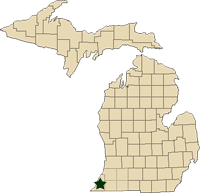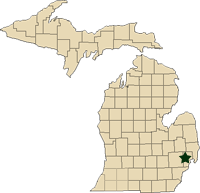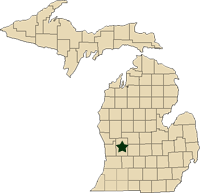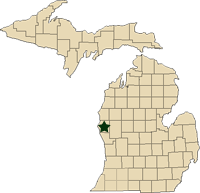Regional reports on Michigan vegetables – June 1, 2011
MSU Extension educators’ pest and vegetable updates for Michigan.
This week’s regional reports:
- Southwest Michigan – Ron Goldy
- East Michigan – Hannah Stevens
- Grand Rapids Area – Bill Steenwyk
- West Central Michigan – Norm Myers
Southwest Michigan – Ron Goldy, Michigan State University Extension
|
Weather
Temperatures averaged mostly below normal except for Monday (May 30) and Tuesday (May 31), which were above normal. Highs ranged from 61 to 89oF and lows from 45 to 60oF. Soil temperatures are in the mid-60s. Precipitation for the area was nearly 3 inches. We continue to be above normal in precipitation for the season with May having between 5.5 and 6 inches.
Field activity
Planting continues as the weather permits. Timing is a few days to several days behind, depending on the crop and the site. Some growers are having difficulty holding transplants and are finding increased fungal and bacterial disease pressure in transplants that should have been planted one to two weeks ago.
Crop reports
Asparagus harvest continues with approximately 75 percent complete. Harvest will probably continue through the next two weeks. Quality is generally quite good now that temperatures have increased.
Peas will probably be in bloom next week.
Potatoes are 12 inches tall and Colorado potato beetle adult populations continue to increase.
Tomatoes grown in tunnels are blooming and setting fruit. Unprotected fields are being planted. Growth is slow due to cool, cloudy conditions.
Pepper and eggplant transplants continue to be set out.
Sweet corn continues to be planted. Early fields are 12 to 14 inches tall and have better color in response to warmer temperatures.
Zucchini and yellow squash transplants in tunnels are close to flower. Growers continue to plant directly.
Pumpkin planting has started, but will increase over the next week.
East Michigan – Hannah Stevens, Michigan State University Extension
|
Field conditions
Soils remain saturated for the most part with five or six days of rainfall in the past week, amounting to 1.6 to 3 inches. A very warm and windy day yesterday (May 31) did little to dry soils to the point where they could be worked. Many acres of crops are yet to be planted and transplants meant for establishing last month are now showing stress and many may not be suitable for the field. Rye cover crops are now in flower and should have been worked down. Growers agree that this is the wettest spring season in memory and the most difficult.
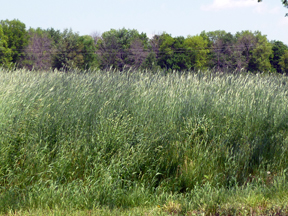
Rye in flower.
Crop conditions
Tomatoes that were established on plastic earlier last month are looking better that most crops, although I have seen Cladosporium leaf mold in one tunnel. Stress is apparent on some tunneled crops such as squash due to the sudden high temperatures over the weekend. I don’t think we will see as many plastic tunnels in the field this season as growers are so late in planting and temperatures are now so warm.
Peas are in flower and a little lettuce is being harvested for farmers markets. Sweet corn made a little progress this past week, but soil conditions are not doing it any good and emergence looks poor. European corn borer has begun flight with one to two moths appearing in traps.
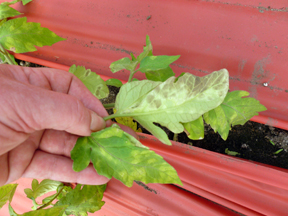
Cladosporium leaf mold.
Grand Rapids Area – Bill Steenwyk, Michigan State University Extension
|
Last week was cool until the holiday weekend. Unfortunately, much of west Michigan has continued to receive unneeded rainfall. Areas south of Grand Rapids have been much wetter than those to the north. In terms of heat accumulation, the region north of Grand Rapids has finally caught up to the cool 2009 growing season. However, areas from south of Grand Rapids to I-94 have only attained 80 percent of the base-50 growing degree days that were achieved in chilly 2009. Warmer temperatures will be welcome.
Water saturation in west Michigan muck fields varies widely and crop condition varies accordingly. Onions are generally looking good, but excessive rainfall has thinned stands in portions of some fields. Growth varies from the loop to three leaf stages. Weed pressure is building in some fields and excessive wetness is making it difficult to spray. I have heard one report of severe damage to onions from seed corn maggot.
The radish crop looks great in the drier soils, but fares poorly in wetter areas. Lettuce, red beets and leeks look good.
Sweet corn planting has progressed slowly due to wet fields. Recent warmth has spurred growth. Squash Cabbage planting and development is well behind normal, with the most mature plants being small seedlings. fields are doing fairly well, but transplanting progress has been slow.
Tomatoes, snap beans and peas appear to look well. Other warm season crops, such as melons, are just starting to get started.
Field work should progress much more rapidly as soils become dryer and warmer.
West Central Michigan – Norm Myers, Michigan State University Extension
|
Weather has been a real rollercoaster ride over the last week. Patchy frost in low spots by major rivers on the morning of May 26 caused no damage to vegetable crops. Very warm, humid conditions prevailed on Monday (May 30) and Tuesday. Most of Oceana and Mason counties were spared the heavy rains that hit southern Michigan on Sunday and, in fact, with the high evapo-transpiration rates we could actually use rain in some spots.
Asparagus production continues to roll along. According to the Michigan Agricultural Crop Marketing Association’s Asparagus Division, even with the late start, asparagus deliveries to processors are still ahead of where we were at this point in the season last year. That isn’t too surprising, since last year’s frost on May 9 resulted in the smallest asparagus crop in over 50 years. Fresh prices continue to be strong, but it is a struggle to deliver a quality product in this heat and humidity. Common asparagus beetle, which always thrives in warm weather, is the major asparagus pest being treated for by local growers, although dark-sided cutworm has also made its appearance. Purple spot, which was a problem in last week’s cool, damp conditions, has disappeared since the weather warmed.
Carrot growers are replanting some of the earliest planted fields, especially farther north. Small grain cover crops have been killed and most preemergent weed control has already been applied. Irrigation will commence on some of the lighter fields if we do not get rain this week.
Growers have begun planting processing winter squash and Jack O’ Lantern pumpkins. Wet spots in a few of the heavier-textured fields are delaying some of that planting. The first early processing zucchini has already been planted and more will go in the ground next week. The first early fields of snap beans are also going in now.



 Print
Print Email
Email